If you’re looking to add a burst of color and charm to your garden, petunias are the way to go!
These versatile and lovely flowers are a favorite among gardeners for their vibrant blooms and easy maintenance.
In this gardening guide, we’ll explore the benefits of growing petunias, discuss some favorite petunia varieties, and delve into the care and cultivation of these beautiful plants.
Benefits of Growing Petunias
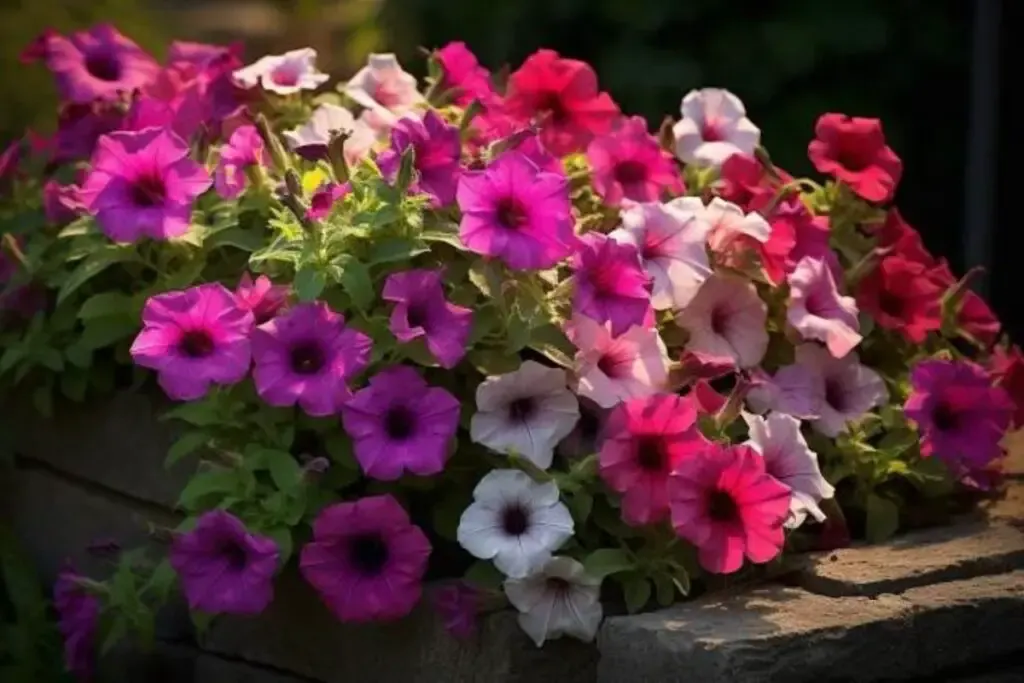
1. Vibrant Blooms
Petunias are renowned for their profuse and colorful blooms. Whether you choose classic shades like purple, pink, or white, or opt for more unique and exotic varieties, petunias are sure to add a touch of elegance to your garden. Their striking appearance can brighten up any landscape.
2. Low Maintenance
Petunias are perfect for both novice and experienced gardeners. They are relatively low-maintenance and can adapt to various growing conditions.
Whether you plant them in the ground or in containers, petunias are forgiving and resilient, making them a hassle-free choice for your garden.
3. Attract Pollinators
These delightful flowers are not only visually appealing but also attract essential pollinators like butterflies and bees.
By planting petunias, you’ll not only enjoy their beauty but also contribute to the biodiversity of your garden.
My Favorite Petunia Varieties
Petunias come in a wide range of varieties, each with its unique charm. Here are a few of my personal favorites:
1. Wave Petunias
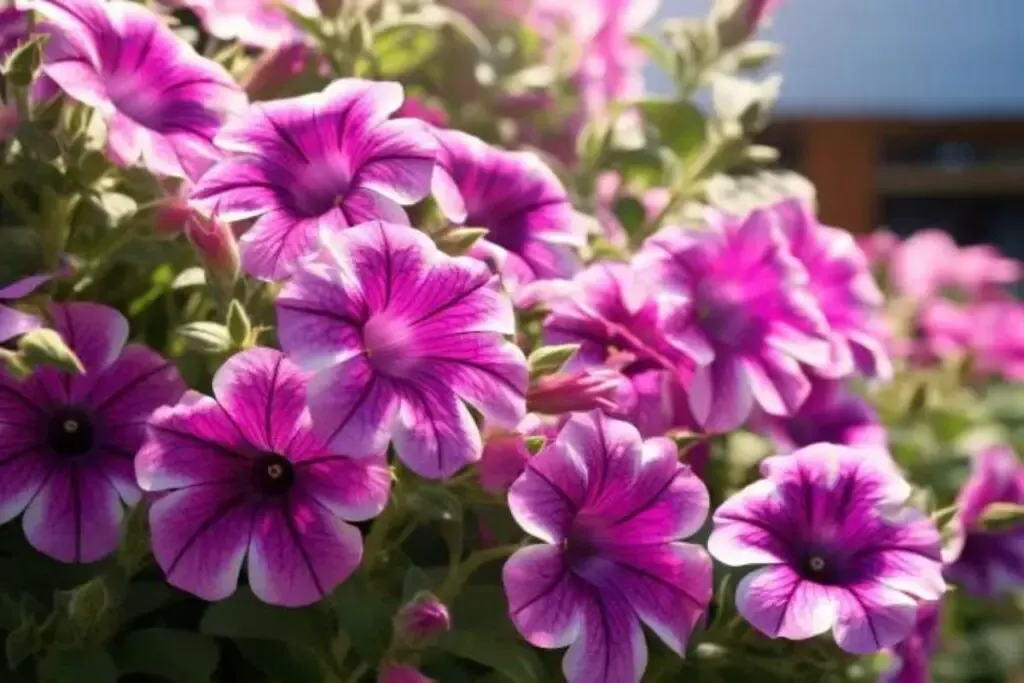
If you’re searching for an easy-to-grow and impressive variety, Wave Petunias are the way to go. They cascade beautifully from containers and hanging baskets, creating a waterfall of color.
Their vigorous growth and stunning blooms make them a top choice for gardeners.
2. Supertunia
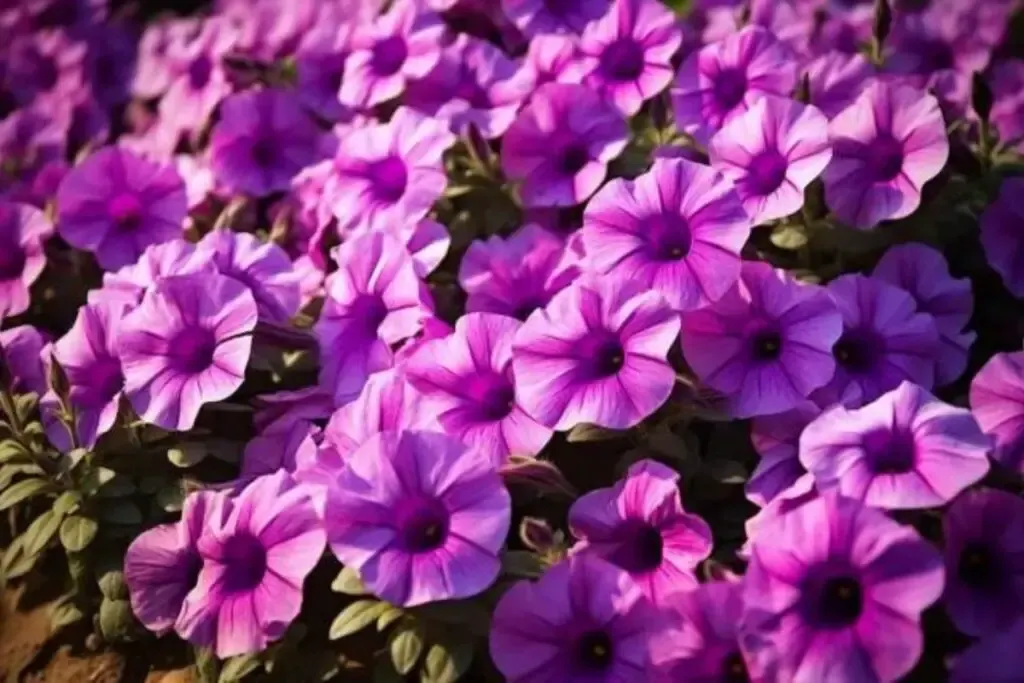
These petunias are known for their exceptional resilience and continuous flowering. They come in a plethora of colors and are perfect for adding a pop of brightness to your garden beds or borders.
With Supertunias, you’ll enjoy vibrant blooms from spring through fall.
3. Million Bells
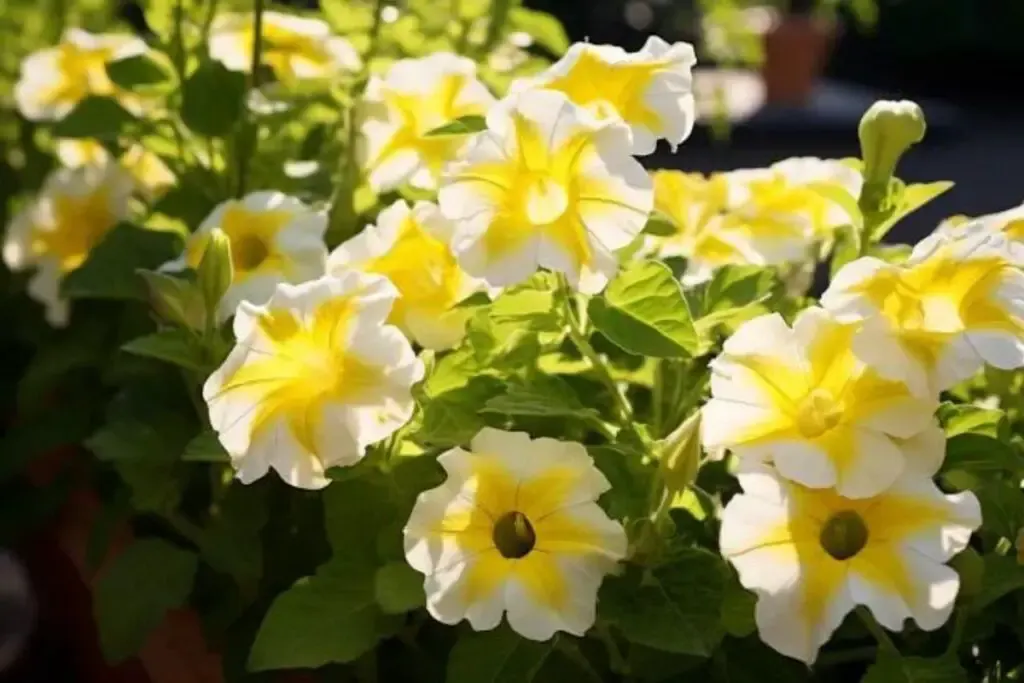
Also known as Calibrachoa, Million Bells resemble miniature petunias. They are charming and dainty, making them an excellent choice for window boxes and containers.
These little gems offer a profusion of blooms and come in various colors.
Petunia Care
Petunias, with their vibrant blooms and ease of care, are a delightful addition to any garden. In this section, we’ll explore the essential aspects of petunia care, from planting to providing the right environment for these lovely flowers to thrive.
Planting
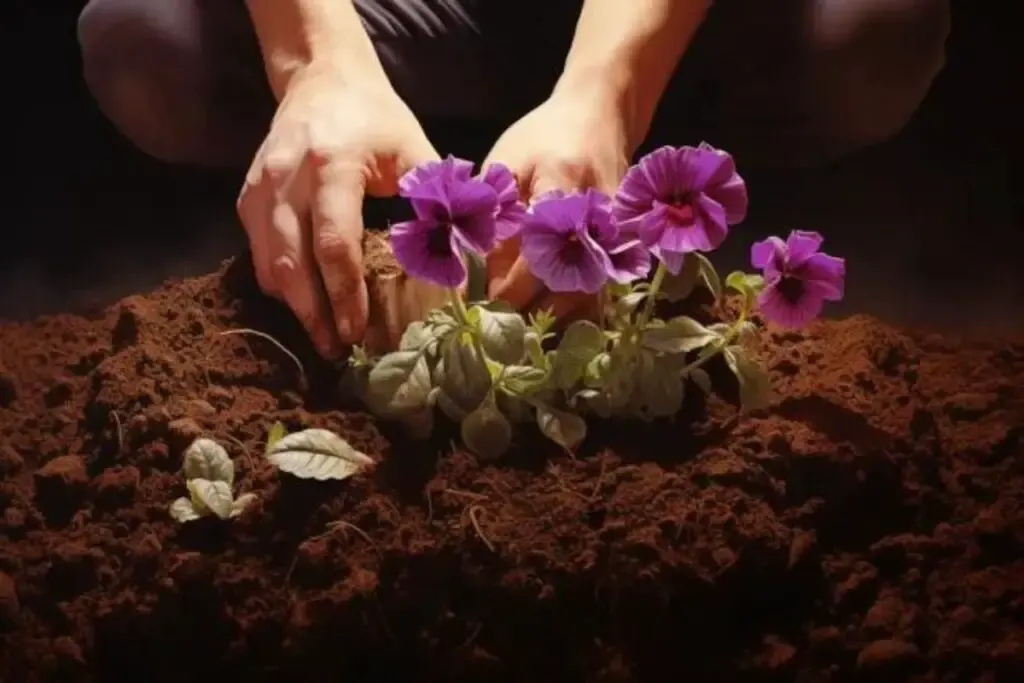
Planting petunias is a breeze and can be done in a few simple steps:
- Choose the Right Location: Select a sunny spot in your garden with at least 6-8 hours of sunlight per day. Petunias love the sun and will reward you with an abundance of blooms in full light.
- Prepare the Soil: Ensure your soil is well-draining and enriched with organic matter. Petunias prefer slightly acidic to neutral soil with a pH level between 6.0 and 7.0. Amending your soil with compost can help improve its quality.
- Spacing Matters: When planting petunias, space them according to their growth habits. For spreading varieties, provide enough room for them to trail or cascade. For upright types, space them 10-12 inches apart to allow for proper growth.
- Planting Depth: Dig a hole for each petunia plant that is about the same depth as the root ball. Gently place the plant in the hole, cover the roots with soil, and press down firmly to remove air pockets.
Light
Petunias are sun lovers through and through. They thrive in full sunlight and need a minimum of 6-8 hours of direct sun each day.
Choose a spot in your garden where they can soak up the sun’s rays to encourage vigorous growth and a profusion of colorful blooms.
Soil
Well-draining soil is crucial for the success of your petunias. They prefer slightly acidic to neutral soil with a pH level between 6.0 and 7.0.
To improve drainage, amend heavy clay soils with organic matter like compost. Good soil preparation is the foundation for healthy petunias.
Water
Petunias like consistently moist soil, but they don’t appreciate being waterlogged. Water your petunias at the base to keep the foliage dry and prevent fungal issues.
During dry spells, water more frequently, but be cautious not to overwater. A simple guideline is to check the top 2-3 inches of soil; if it’s dry, it’s time to water.
Temperature and Humidity
Petunias thrive in moderate temperatures and can withstand some heat. They prefer a cooler nighttime temperature to promote blooming.
Adequate humidity levels are generally not a concern for these hardy plants. Just ensure they receive the right amount of sunlight and don’t experience extreme temperature fluctuations.
Fertilizer
Fertilizing your petunias is essential for vibrant blooms. Apply a balanced, all-purpose fertilizer according to the package instructions.
You can also opt for a slow-release fertilizer to provide nutrients gradually. Be mindful not to over-fertilize, as this can lead to excessive foliage growth at the expense of flowers.
Pruning
Pruning is a valuable practice in maintaining healthy and vigorous petunias. By removing spent blooms and leggy growth, you can encourage continuous flowering and maintain an attractive appearance.
Here are three essential pruning tips for your petunias:
- Deadheading: Regularly remove faded or dead flowers by pinching them off just above the nearest set of leaves. Deadheading not only keeps your petunias looking tidy but also redirects the plant’s energy into producing new blooms rather than forming seeds.
- Trimming Leggy Growth: If you notice your petunias becoming leggy with long, straggly stems, don’t hesitate to trim them back. Use clean and sharp scissors or pruning shears to cut back the stems by about one-third. This will encourage bushier growth and more flowers.
- Thinning: To prevent overcrowding and enhance air circulation, consider thinning your petunias when they become too dense. Carefully remove a few of the older, crowded stems from the center of the plant. This allows sunlight and airflow to reach the inner foliage, reducing the risk of disease.
Propagating
Propagating petunias can be a rewarding way to expand your garden without purchasing new plants. Here are two common methods for propagating petunias:
- Cuttings: Take 4-6 inch cuttings from healthy, non-flowering stems of your petunia plant. Remove the lower leaves, leaving only a few at the top. Dip the cut end in rooting hormone (optional) and plant the cutting in a well-draining potting mix. Keep the soil consistently moist and provide indirect light. After a few weeks, the cuttings should develop roots and can be transplanted into the garden.
- Seeds: Collect seeds from your petunias when the flowers have faded and turned into seedpods. Allow the pods to dry on the plant, then open them to retrieve the seeds. Plant the seeds in seed trays or pots filled with a seed-starting mix. Keep the soil moist and provide bright, indirect light. Once the seedlings have grown large enough, they can be transplanted into your garden.
How to Grow Petunias From Seed
Growing petunias from seed is a cost-effective way to fill your garden with these colorful flowers. Here’s how to do it:
- Seed Starting: Start your petunia seeds indoors 8-10 weeks before the last expected frost date in your area. Plant the seeds in trays or pots filled with a seed-starting mix. Lightly press the seeds into the soil but do not cover them; petunia seeds need light to germinate.
- Temperature and Light: Maintain a warm temperature of around 70-75°F (21-24°C) for germination. Place the seed trays in a bright location with indirect sunlight. Once the seedlings emerge, provide them with 14-16 hours of light per day using fluorescent grow lights or by placing them near a sunny window.
- Transplanting: When the seedlings have developed at least two sets of true leaves, they are ready to be transplanted into individual pots or directly into your garden. Harden off the seedlings by gradually exposing them to outdoor conditions for about a week before transplanting.
- Spacing: When planting seedlings in your garden, space them 10-12 inches apart to allow for proper growth and air circulation.
Growing Petunias in Pots
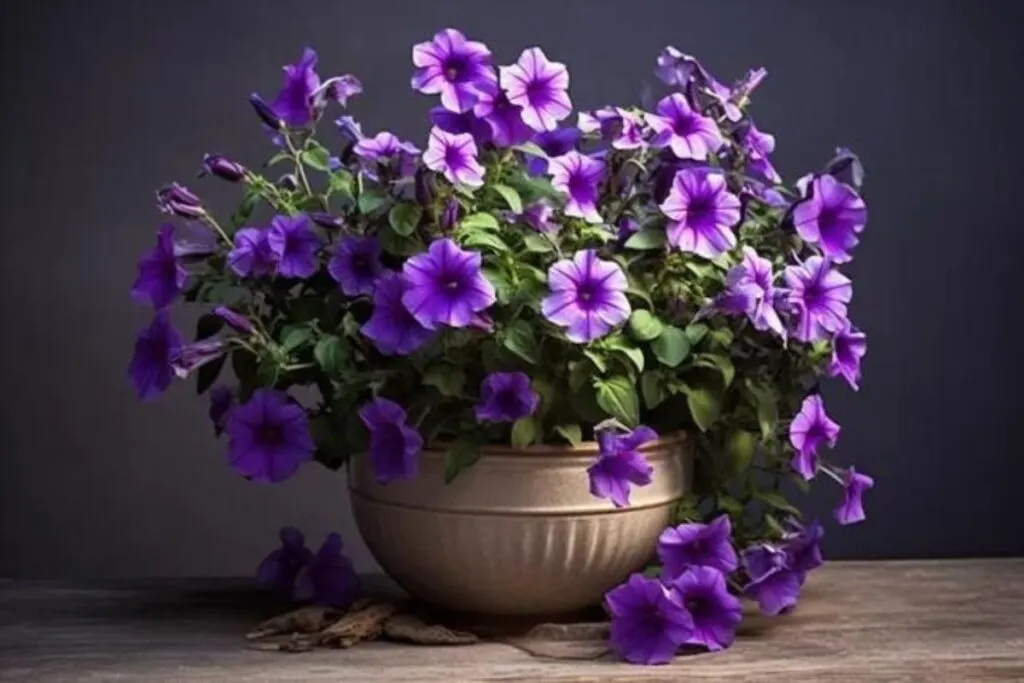
Petunias are perfect candidates for container gardening, and they can thrive in pots, hanging baskets, and window boxes. Here’s how to grow petunias in pots:
- Container Selection: Choose a container with drainage holes to ensure proper water drainage. A pot with a diameter of at least 12 inches is suitable for accommodating petunias.
- Potting Mix: Use a high-quality potting mix that provides good drainage. You can also add some slow-release fertilizer to the mix to provide essential nutrients throughout the growing season.
- Planting: Plant your petunias at the same depth they were in their nursery containers. Space multiple petunia plants according to their recommended spacing, usually 10-12 inches apart.
- Watering: Water your potted petunias consistently, keeping the soil evenly moist but not waterlogged. Ensure that excess water can drain from the pot to prevent root rot.
- Fertilizing: Apply a balanced, water-soluble fertilizer according to the package instructions. Container-grown plants may require more frequent feeding to thrive.
Overwintering
Overwintering your petunias can be a great way to ensure their survival and enjoy their blooms for another season. Here’s how to do it:
- Container Plants: If you have petunias in pots or containers, consider bringing them indoors before the first frost. Place them in a cool, bright location with temperatures around 45-50°F (7-10°C). Water sparingly to keep the soil from drying out completely. With proper care, your petunias may survive the winter and can be reintroduced to the garden in the spring.
- In-Ground Plants: For petunias planted in the ground, you can treat them as annuals and replant new ones each year. However, if you want to attempt overwintering, cut back the plants to a few inches above the soil surface after they have stopped blooming in the fall. Apply a layer of mulch to protect the roots from freezing temperatures. While not all petunias will survive the winter in colder climates, this method may work in milder regions.
Transplanting
Transplanting petunias can help you rearrange your garden or share your beautiful flowers with friends and neighbors. Here’s a simple guide to transplanting petunias:
- Choose the Right Time: The best time to transplant petunias is in early spring or late summer when temperatures are mild, and the plants are not in full bloom. This reduces transplant shock and increases their chances of thriving in their new location.
- Prepare the New Location: Ensure the new planting site has well-draining soil and receives the appropriate amount of sunlight for petunias (preferably full sun). Amend the soil with compost if needed to improve its fertility.
- Dig Up the Petunias: Gently dig up the petunias, taking care not to damage their roots. Dig a hole in the new location that is slightly larger than the root ball of the petunia.
- Transplant Carefully: Place the petunia in the new hole at the same depth it was previously planted. Fill in the hole with soil and water thoroughly to help the plant establish itself.
- Maintain Proper Care: After transplanting, keep the soil consistently moist for a few weeks to help the petunia adjust to its new home. Continue regular care as you would for established plants.
Common Pests & Diseases
While petunias are generally hardy, they can still face some common pests and diseases. Here are a few to watch out for:
Pests
- Aphids: These tiny insects can suck sap from petunia leaves and flowers. Control them with a strong spray of water or insecticidal soap.
- Whiteflies: Whiteflies can cause yellowing and wilting of petunia leaves. Use sticky traps or insecticidal soap to manage infestations.
- Slugs and Snails: These creatures can munch on petunia leaves, leaving behind holes. Protect your plants with physical barriers or slug and snail baits.
Diseases
- Powdery Mildew: Powdery mildew can develop as a white, powdery substance on petunia leaves. Improve air circulation and use fungicidal sprays to combat this issue.
- Botrytis Blight: Gray mold, or botrytis blight, can affect petunia flowers. Remove infected plant parts and ensure proper spacing to reduce humidity around the plants.
With the right care and attention, you can overcome these common challenges and enjoy the beauty of petunias in your garden year after year. Happy gardening!
